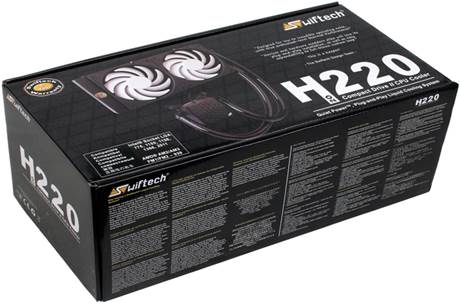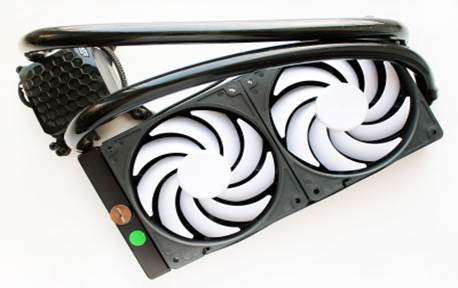Producers specializing in producing components
for liquid cooling system have put forward the idea of an affordable liquid
cooling solution. Let’s see how it works.
For nearly 20 years, the California-based
Swiftech has produced components for liquid cooling system. Started from electric
heating elements and simple aluminum radiators, currently produces all sorts of
components, including a comprehensive arsenal of components for building any
kind of liquid cooling system.
Swiftech should be given credit for quickly
completing any of its products, from radiators, pumps, water blocks to fittings
and controllers. The company is now introducing innovations, on a regular basis
and to the envy of other brands.
Of course, it cannot bear following recent
trends in mass producing compact entry-level cooling system. Frankly speaking, the
Swiftech H220 is not really expensive and compact; however, it only costs
one-half of other ordinary cooling systems and is comparable to top-end
products from Corsair and Thermaltake. Let’s have a closer look.
Packaging and Accessories
The Swiftech H220 has gone on sale but only
recently, so we tested it before selling out, packed in a plain white box:

Swiftech
H220 packed in a plain white box
Though, we still try to find a picture of
the retail packaging at the official Swiftech website:

Swiftech
H220 in retail packaging
As you can see, it is highly informative.
We cannot say anything about its protective properties, but Swiftech has always
been careful in packaging.
Our sample came with full accessories
including fasteners, thermal grease, screws, a PWM controller and a user manual
in 9 languages.

Full
accessories of Swiftech H220
Like almost all products of Swiftech, H220
was developed in the US but was manufactured in China. Its recommended price is
$139.55 with the warranty period of 3 years.
Design and Function
Swiftech H220 is a closed- circuit liquid
cooling system, filled with coolant and ready to work. Like most serially
manufactured cooling system of this kind, it includes a radiator with fan, a
pump/waterblock combo and two pipes connecting these components.

Swiftech
H220 includes a radiator with fan, a pump/waterblock combo and 2 pipes
Having a huge number of liquid cooling
components of any class at its disposal, Swiftech went the simplest way and
just built the H220 out of existing products.
The system is based on the 240mm MCR-X20
Drive Rev3 radiator.

Swiftech
H220’s 240mm MCR-X20 Drive Rev3 radiator
Its total thickness is 29mm but the body is
24.5mm think.
The radiator’s dimensions are detailed in
the following picture:

Radiator’s
dimensions
The basic difference between radiators and
other inexpensive products is the material. When liquid cooling systems of
Corsair, Zalman and Thermaltake use aluminum radiators, Swiftech offers a
copper one.
There is no doubt about that. Firstly, it’s
very heavy. And secondly, you can see the perforated copper ribbon easily.

Swiftech
H220’s perforated copper ribbon
The radiator has 12 similar pipes that
contain coolant. The perforated copper ribbon is welded in between pipes. So,
it is a classic solution but the high-end material must be noted.
Two rotating 10mm fittings go out of one
side of the radiator. Pipes with an outer diameter of 16mm are secured on them
with screw clamps.
These pipes are very soft and flexible but
also think enough to avoid bending and stopping the flow of coolant. They are
405mm long.
On the other side of the radiator, there is
a small expansion tank with a stopper.

Stopper
on a side of the radiator
So, unlike other compact liquid cooling
systems, Swiftech H220 looks quite durable. You can add more coolant and other
additional components as the pipes are not fixed in place but secured by
clamps. This is an important pros.
Now, let’s check out the pump and
waterblock. This is a PWM-adjusted MCP350 pump model we’ve already met in our
reviews. Meanwhile, this latter product is an excellent copper waterblock
Apogee XT that features a micro-channel structure.

Swiftech
H220’s copper waterblock
The pump is installed above the waterblock
from which both fittings stick out. Unfortunately, Swiftech H220’s standard
specifications do not mention the pump’s performance (only mention its speed:
1200-3000 RPM with PWM- based controller) but we suppose that it is 440 liters
per hour as original MPC350 standard. Pump life is expected to serve at least
60,000 hours while its peak power consumption is 6 watts.
The waterblock is connected to the mainboard
by four 290mm-long wrapped cables. Its dimensions are 62x62x56mm. We’ve tested
the Apogee XT waterblock in a previous review and it is unchanged in the H220.
It still has a micro channel structure and a perfect base.

Waterblock’s
base
However, the heat sink imprint on our CPU
is not really perfect:

The
heat sink imprint on the CPU
It is because the CPU has a convex
heat-spreader. This does not affect the cooler’s performance much as you will
see in our test, anyway. We can add waterblock’s fittings that can be bended,
make it easier to install in a CPU.
Swiftech H220’s radiator carries 2 Helix
120 PWM 120mm fans which we tested before.

Radiator’s
fan
The fan’s speed is adjusted by PWM from 800
RPM to 1800 RPM. The air flow varies from 24 CFM to 55 CFM, the static pressure
from 0.53 mm to 2.99 mm of water and the noise from 16 to 33 dBA. The improved
lifespan is 60,000 hours. The fan’s 4 cables are 395mm long.